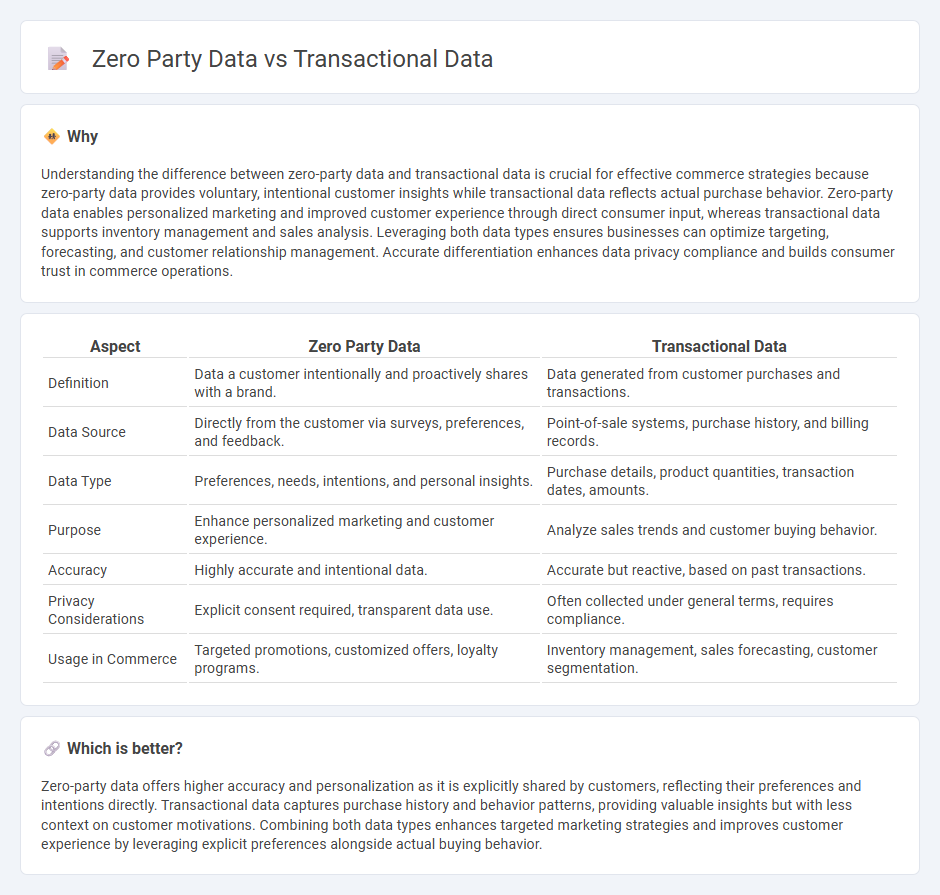
Zero-party data, collected directly from consumers through surveys, preferences, and intentional sharing, offers businesses personalized insights without reliance on tracking technologies. Transactional data captures purchase history and interaction records, providing essential information for analyzing consumer behavior and sales trends. Explore the differences and advantages of zero-party versus transactional data to enhance your commerce strategy.
Why it is important
Understanding the difference between zero-party data and transactional data is crucial for effective commerce strategies because zero-party data provides voluntary, intentional customer insights while transactional data reflects actual purchase behavior. Zero-party data enables personalized marketing and improved customer experience through direct consumer input, whereas transactional data supports inventory management and sales analysis. Leveraging both data types ensures businesses can optimize targeting, forecasting, and customer relationship management. Accurate differentiation enhances data privacy compliance and builds consumer trust in commerce operations.
Comparison Table
| Aspect | Zero Party Data | Transactional Data |
|---|---|---|
| Definition | Data a customer intentionally and proactively shares with a brand. | Data generated from customer purchases and transactions. |
| Data Source | Directly from the customer via surveys, preferences, and feedback. | Point-of-sale systems, purchase history, and billing records. |
| Data Type | Preferences, needs, intentions, and personal insights. | Purchase details, product quantities, transaction dates, amounts. |
| Purpose | Enhance personalized marketing and customer experience. | Analyze sales trends and customer buying behavior. |
| Accuracy | Highly accurate and intentional data. | Accurate but reactive, based on past transactions. |
| Privacy Considerations | Explicit consent required, transparent data use. | Often collected under general terms, requires compliance. |
| Usage in Commerce | Targeted promotions, customized offers, loyalty programs. | Inventory management, sales forecasting, customer segmentation. |
Which is better?
Zero-party data offers higher accuracy and personalization as it is explicitly shared by customers, reflecting their preferences and intentions directly. Transactional data captures purchase history and behavior patterns, providing valuable insights but with less context on customer motivations. Combining both data types enhances targeted marketing strategies and improves customer experience by leveraging explicit preferences alongside actual buying behavior.
Connection
Zero party data, collected directly from customers through preferences and intentions, complements transactional data by providing contextual insights into purchase behavior. Combining zero party data with transactional data enhances personalized marketing strategies, increasing customer engagement and conversion rates. Leveraging both data types enables businesses to create targeted offers and improve customer lifetime value through more accurate segmentation.
Key Terms
Purchase History
Purchase history, a key component of transactional data, records actual buyer behavior and completed sales, providing insights into consumer preferences and spending patterns. Zero party data differs by capturing explicit information willingly shared by customers, such as preferences and intentions, which may not be reflected in transaction records. Explore how leveraging both data types enhances personalized marketing strategies and customer engagement.
Customer Intent
Transactional data captures past customer purchases and interactions, offering insights into buying behavior and spending patterns. Zero party data reflects explicit customer intent, preferences, and personal feedback shared directly with a brand, providing deeper understanding of customer desires and motivations. Discover how leveraging both data types can enhance personalized marketing strategies and drive customer engagement.
Explicit Consent
Transactional data captures user behavior from purchases and interactions, often collected implicitly without direct user consent. Zero-party data involves users explicitly sharing preferences, intentions, and personal information, ensuring transparent consent and higher data accuracy. Explore how leveraging explicit consent through zero-party data can enhance personalized marketing efforts and customer trust.
Source and External Links
Master Data vs. Transactional Data: Unveiling the Data Symphony - Transactional data is information created from specific business transactions like sales or purchases, characterized by its time-sensitivity, dynamism, granularity, and temporary nature, capturing the who, what, when, and where of each event.
What is transactional data? | Definition from TechTarget - Transactional data uniquely identifies each business transaction with details such as a unique ID and timestamp, managed often in relational databases supporting ACID properties, and includes events like product sales, purchases, and payments.
What is Transactional Data? - Explanation & Examples - Secoda - Transactional data records the specifics of business events (e.g., sales, payments), is essential for improving business performance through analytics, and requires robust management due to challenges like volume, quality, and integration difficulties.
 dowidth.com
dowidth.com